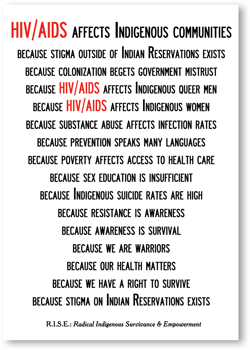 |
| The powerful poster by R.I.S.E., an Indigenous artist/activist/warrior collective, was released on World AIDS Day, December 1, 2014. |
What inspired its creation is the absence of art production in Indigenous communities that broaches HIV/AIDS.
Using the inspiration of World AIDS Day, Day With(out) Art and November’s National American Indian Heritage Month, I began working on a large, text-heavy poster that lays out a few facts. I wanted to link thriving and struggling Indigenous communities to taboo issues like HIV/AIDS.
I also wanted to challenge other Indigenous artists/activists to create a space for HIV/AIDS in their communities and ceremonies that simultaneously takes into account the impacts of colonization, disease and government neglect in the hopes of healing.
The same goes out to HIV/AIDS and queer artists/activists: I want all of us to challenge the work we make so it includes Indigenous voices.
What is the meaning of “Survivance”?
In his writing on the issue, Anishinaabe scholar Gerald Vizenor states, “Survivance is an active sense of presence, the continuance of native stories, not a mere reaction, or a survivable name. Native survivance stories are renunciations of dominance, tragedy and victimry.”
Every morning Indigenous Peoples of the Americas wake up in the colonized lands that stretch from Canada to Tierra del Fuego, and in those first few moments of the day they are making a political statement of resistance.
The issues that R.I.S.E. is dedicated to addressing fall under the categories of decolonization, indigenization, feminism and political activism, and we do this through curatorial inquiry, public interventions, wheatpaste/street art and by creating free digital posters for download at burymyart.tumblr.com.
Survivance is a part of our agenda. Empowering our community and dedicating ourselves to our artwork is another part. It’s a lifelong battle that must be fought to ensure the perseverance of land and people, but also to re-establish the relationship of the people to the land. It’s not just an Indian thing; it’s a human necessity.
What was it like creating the poster?
I woke up at 4:30 one morning and knew I wanted to make a poster. I started off as a writer, so most of the images that come to mind are text-based.
Sometimes I include photography, Native-inspired designs, and appro-priated photographs or designs, like with the ongoing #decolonizefeminism series [see examples above] that utilizes appropriated images of Indigenous women with original text.
In this case, I originally was shooting for an upside-down triangle, because queerness is heavily embedded in my politics. But I realized that I wanted to distract the reader by creating an abstract image. I wanted to infect the reader’s mind with an image that was aesthetically rigid. The use of repetition allows the reader an entry point into any line. It allows for a gradient of meaning and it creates a cohesion that ties and binds all the issues addressed. I also was influenced by traditional Diné (Navajo) songs, which use repetition as a way to speak of continuity.
It is our duty as human beings of this living continent to make radical changes to the way we think of history, health, creating diverse communities, and our relationship to living organisms. Hopefully we can all work together to ensure our own acts of survivance.
Click here to read the full blog post.
—Visual AIDS
blogs.poz.com/visualaids






Comments
Comments